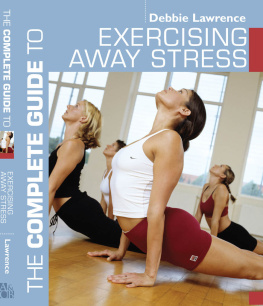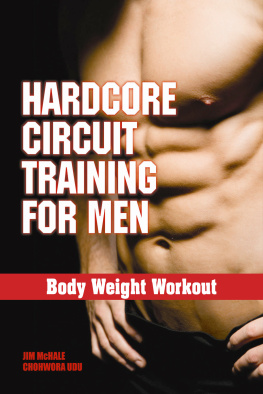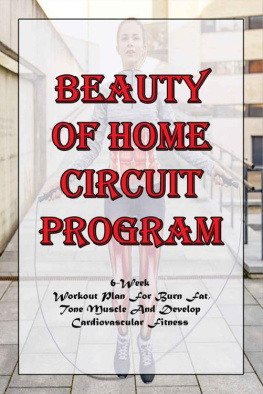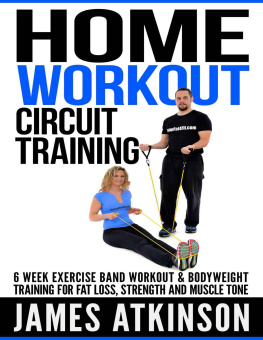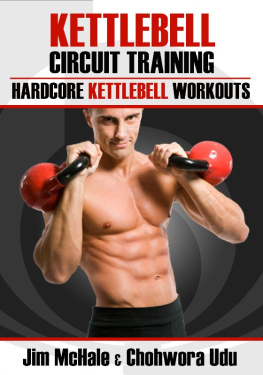THE COMPLETE GUIDE TO CIRCUIT TRAINING
Second edition
Debbie Lawrence and Bob Hope

Contents
Circuit training is often erroneously portrayed as an intensive and stressful form of exercise, with a drill sergeant-type in the middle of a circuit bellowing orders at weary recruits. While circuit training can be used as an advanced form of training, we aim to demonstrate that it is simply another method of training to develop fitness. Circuit training is a very versatile and adaptable mode of training that requires the performance of a series of carefully selected exercises. The exercises chosen can be used to develop a specific component of fitness, specific skills for a particular sport, or for the needs of a particular specialist population. They can also be adapted to suit a wide range of fitness levels and to build an individuals or a teams fitness level as they improve. Participants often enjoy circuit training more than other modes of training because they are able to easily monitor their progress and really see the results of their hard work. Ultimately, there are numerous ways of modifying a circuit training session, which adds variety and fun and helps to maintain interest and motivation, so that those taking part are more likely to adhere to the exercise programme and to enjoy it at the same time!
The aim of this book is to explore the benefits and techniques of circuit training. Now fully revised from the first edition with updated information and additional material, and with key exercises demonstrated by photographs, it will act as a resource for circuit training teachers and also as a reference for sports coaches who need access to creative circuit ideas designed specifically for their sport.
Part One provides a basic introduction to fitness: why fitness is important both physical and mental; and how fitness can be improved through training specifically through circuit training.
Part Two identifies the skills required to plan, lead and teach a circuit training session. It outlines the necessary safety considerations and explores different approaches to circuit training, discussing the advantages and disadvantages of each. The final chapters look at different programme formats and methods of progressing and adapting each to accommodate the needs of participants.
Part Three discusses and demonstrates appropriate activities for warming up and cooling down, along with appropriate activities, exercises and session structures to improve the main components of fitness.
Part Four provides detailed instructions on how to perform and instruct a range of exercises appropriate for outdoor circuit training, training for older adults, and circuits for specific sports.
Part One
Why Circuit Training?

1
The benefits of circuit training
WHAT ARE THE GENERAL BENEFITS OF CIRCUIT TRAINING?
Circuit training is a safe, effective and fun approach to exercising that can be enjoyed by a variety of people; it is attractive to men and women, younger and older age groups, sportspeople and the general population. It can be performed indoors and outdoors, and in water.
To fully understand the benefits of circuit training it is necessary to explore the components of physical fitness and discuss how each of these can be improved through participation in a progressive circuit training programme. The components that contribute to physical fitness are:
cardiovascular fitness
muscular strength
muscular endurance
flexibility
motor fitness (includes agility, balance, reaction time, speed, power and co-ordination).
It is also necessary to discuss how to progress these fitness components and provide overload to the specific physiological systems. Therefore, the principles of training will also be discussed in relation to each component of fitness. Principles include:
frequency (how often)
intensity (how hard)
time/duration (how long)
type of training.
The contributions that circuit training makes to health and wellbeing will also be explored in relation to the following components, which are believed to encompass most aspects of total fitness/health:
physical fitness
social fitness
mental fitness
emotional fitness
nutritional fitness
medical fitness
spiritual fitness.
This chapter therefore explores how participation in a progressive circuit training programme can contribute towards improving and developing our physical fitness and lead us towards the optimum of total fitness.
AEROBIC AND ANAEROBIC
The body has to create energy to function both during times of rest and activity. This energy comes in the form of a chemical called Adenosine Tri Phosphate (ATP). ATP cannot be stored inside a muscle in large amounts, but is continually broken down to create energy and then reproduced inside the muscle via the bodys energy systems (aerobic or anaerobic).
When resting and inactive, demands for energy and ATP production are lower. During exercise and activity, the demands for energy and ATP production are greater to enable muscle contraction and all the other physiological processes required by the exercising body.
The main factors that determine the energy system used to re-synthesise ATP are the:
intensity of the activity;
duration of the activity;
fitness level of the person performing the activity;
skill level of the person performing the activity that is, how familiar they are with performing that activity (specificity).
Generally speaking, activities which are of a lower intensity and can be continued for longer durations will use the aerobic energy system predominantly. This means the individual will be using oxygen to create energy. Activities that are of a higher intensity and can only be performed for shorter durations will use the anaerobic energy systems, which do not use oxygen to create energy. This means the individual would not be using oxygen to perform the activity and therefore would have to slow down or stop because the energy source had expired or a build-up of waste products (lactic acid, which causes the burn) would inhibit further work.
Realistically, during a circuit training session, all the energy systems will interweave to enable activities of different intensity to be performed. At different times throughout the workout, certain energy systems may be more predominant.
A basic introduction and summary of the bodys energy systems is provided in . Readers wishing to study further are recommended to read other anatomy and physiology texts listed in the references.
Table 1.1 The bodys energy systems


WHAT IS CARDIOVASCULAR FITNESS?
Cardiovascular fitness is the ability of the heart, lungs and circulatory system to transport and utilise oxygen efficiently. It is sometimes referred to as cardio-respiratory fitness, stamina, or aerobic fitness.


